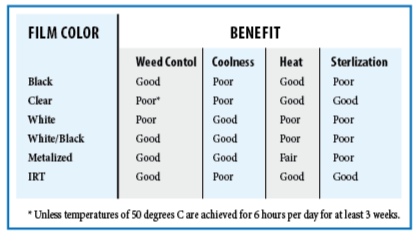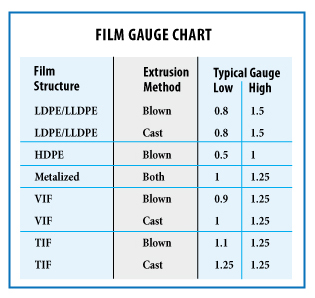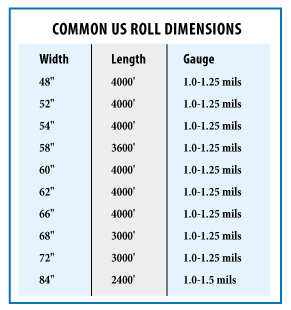Plastic Mulch Films
Plastic mulch film has become the core technology in vegetable, berry and hemp production. Plastic mulch film serves so many purposes and has proven to more than pay for itself in most high value crops. The grower can choose different plastic mulch films to accomplish different objectives depending upon particular needs. Mostly, plastic mulch film serves to suppress weed growth, control bed temperature, protect against leaching of fertilizers, increase the efficacy of fumigation and protect the crop from touching the soil directly. Altering the plastic mulch film color, barrier properties, thickness and other characteristics (surface, construction, resin type, etc.) different benefits can be achieved.
Intergro has been providing plastic mulch film solutions to growers for more than 44 years and offers a complete line of Blown and Cast plastic mulch films, including organic use, biodegradable, smooth, embossed, standard, VIF, TIF, in all colors and specifications.
Mulch Film Colors
Using different colors of mulch film, a grower can positively affect the crop outcome. Some colors benefit a crop dramatically, other colors provide a limited benefit and still other colors probably offer no benefit but can add quite a bit to a grower’s cost. The following is a summary of the common colors being used today:

Black: Black is the most common color of plastic mulch film used in the US today. It is perhaps the least expensive to make and can provide great benefits to the grower. Black plastic mulch films can provide heat to the bed via absorption and transfer of solar heat to the soil. With outside temperatures in the 80s, soil temperature at 2’-4” can raise as high as 115 degrees. Black mulch film can also reduce weed pressure by blocking light from reaching the soil.
Clear: Clear plastic mulch film is most commonly used as a solarization aid. Light passes directly through the mulch film and the soil is greatly heated below killing weed spores and bacteria living in the bed. Temperatures of at least 50 degrees C must be reached for 6 hours per day for 3-4 weeks in order for solarization to have the desired effect. Otherwise, clear plastic mulch film does nothing to inhibit weed growth.
White: White plastic mulch film reflects light and provides for a significantly cooler bed than almost any other color. It is UV stabilized for one year usage in typical US climates. It does not block enough light to inhibit weed growth. It is best used in climates that are exceedingly hot.
White/Black: This co-extruded plastic mulch film provides the combined benefits of black mulch film and white mulch film all in one product. Made properly with enough white colorant, it provides ample coolness but the underlying black layer still absorbs enough light to inhibit weed growth. Although not typically as cool as pure white plastic mulch films, it is still a very effective mulch film for hot climates.
Metalized: The benefits to metalized plastic mulch films are many. Metalized films provide extra light to the plant and reflect a range of light which can partially deter disease carrying aphids and white flies. It has been shown to provide a narrower range of soil temperatures between the heat of the day and the cold of night. It also has been proven to have significant barrier properties which will allow a farmer to cut the rate of fumigation used or increase the efficacy of a standard application. The metal coating is typically applied to either a black or white base film depending on the time of year that the film will be used.

IRT: IRT plastic mulch films come in a variety of colors, typically from green to brown hues. The colored films filter the light that is allowed to pass through to the bed. They allow heat to pass to the soil while blocking light ranges that aid in weed growth. These films produce some of the hottest soil temperatures and are considered effective with weed control. Other Colors- There are a host of other colors that come and go over time. Some of these colors have merit in a controlled setting like a laboratory but do not perform well in the field due to discoloration by copper applications, dust, fading, etc. They are typically expensive and their consistent benefit to yields is dubious.
Vapor Shield
Recently Intergro introduced our newest plastic mulch film product Vapor Shield. Vapor Shield is our new line of metalized plastic mulch film. Building upon our 10 year history with metallization, we developed a superior metalized plastic mulch film. With over 50,000 rolls currently in use, the mulch film has proven to have superior adhesion qualities, excellent strength characteristics and industry leading reflectivity or gloss. The plastic mulch film is available with metal over a white or black base poly ethylene and metal coverage can be complete or with a non-metalized 8” stripe down the center. Ask one of our sales reps for more information and a demonstration in your field.

Mulch Film Barrier
With the phase out of methyl bromide continuing and with the increased regulation around the use of fumigants in general, the barrier properties of plastic mulch films have been brought into the spotlight. The barrier properties of plastic mulch films vary greatly and so does the cost.
Most plastic mulch films are made of low density polyethylene (LDPE) or linear low density polyethylene (LLDPE). LDPE alone is limited in the barrier properties it can provide. We found that even at high rates of Methyl Bromide, there was not a trace of the gas left after 48 hours in warm climates. Conversely, with some ultra high barrier films, the gas can stay around so long that it delays planting and creates the possibility that a grower will miss his planting window.
The various film structures that are commonly found in the US include the following:
LDPE/LLDPE: Mono-layer or co-extruded poly ethylene. This is considered the most standard type of film found in the US.
HDPE: High density blended films which are stronger than traditional LDPE. They provide greater strength at lower gauges but they also are stiffer and more difficult to lay.
Metalized: Usually LDPE films that are coated with a microscopically thin layer of pure aluminum. The amount of aluminum used is so small that it is less than 1% of the weight of the roll.
VIF: This is typically a 5 layer film where the outer two layers are LDPE. The innermost layer is nylon and it is surrounded by a tie layer on each side.
TIF: TIF’s structure is generally the same as VIF except the center layer which produces the barrier is made of EVOH instead of nylon.
For many years, the method for measuring permeability was test ASTM F739-99A. The test measured gas diffusion through a sample film from one chamber where there is a constant flow of gas to another chamber where there is a constant flow of air. The results were expressed in grams per meter squared per hour.
Results varied by plastic mulch film type but generally fell into the following categories:
The gauge of the film in the case of LDPE standard films did have an effect on barrier. We tested 1.0 mil standard LDPE films that scored 190 and we tested 2 mil standard LDPE films that scored 78. However, the gauge had little effect compared to the film structure. As you can see above, by coating a film with aluminum, the barrier properties improved from 100 g/m2/h to 2 g/m2/h. VIF structured films dropped the transmission rate down below .2 and TIF films had no detectable emission rate.
Plastic Mulch Film Thickness
The mulch film thickness or gauge of films has changed over the years. Below is a chart of typical gauges found on the mulch film structures most commonly found in the US:

Standard Roll Size & Packaging
Here is a chart of many of the most commonly found plastic mulch film roll sizes in the US. Mulch film rolls made in the US are not typically individually wrapped. Usually each roll has a production label affixed to the interior of a 3” paper core and then a core plug is inserted at each end to protect the core from crushing. The traditional method of packaging film is to stack 16 rolls on a pallet in 4 levels of 4 rolls each. The rolls are laid into cradles and strapped to the pallet and covered with a shroud to protect the mulch film from the sun. The entire pallet is then stretch wrapped and labeled.
Formula to Calculate Roll Weight:
Roll Weight = (roll width x length x gauge x 12)/30,000

